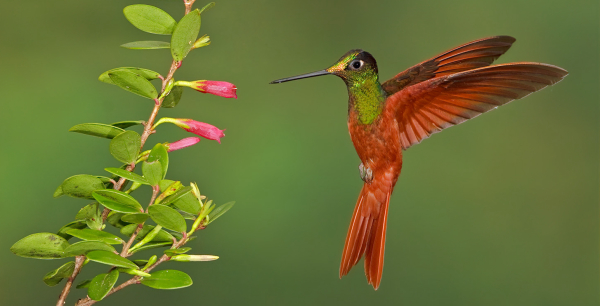
WoW! As a Rainbow Starfrontlet approached a nectar-producing flower in southern Ecuador it was photographed by Glenn Bartley, who can be counted among the best bird photographers.
This week I was presented with the opportunity to highlight the best of the best hummingbird photos taken by Glenn Bartley, co-author of Hummingbirds, the remarkable new book featured in this issue’s Products section. I was so impressed with the quality of both the text and the photographs that I wanted to share some selected photographs to show a fraction of the variety of species that illustrate the book so well that one could imagine it as an art piece of natural history. Here we are emphasizing the photos, equipment, and locations of the spectacular birds photographed by Glenn Bartley, but let me note that his co-author, Andy Swash, is equally proficient as a photographer and his photos are also widely featured in the book.
Hummingbirds features more than 540 spectacular color photographs of hummingbirds! Truly an American family of birds, a total of 369 widely different species of hummingbirds are found from Alaska to Argentina, but nowhere in the Eastern Hemisphere – hummingbirds are only found in the Western Hemisphere – the Americas. Beyond the notion that there is a single kind of hummingbird, imagined by too many non-birders, the book showcases this tremendous family of birds, the Trochilidae, in which we are introduced to the full variety of hummingbirds with names like sunangel, comet, emerald, starthroat, firecrown, sungem, brilliant, sapphire, woodstar, snowcap, inca, coquette, hermit, woodnymph, hillstar, coronet, carib, mango, goldenthroat, metaltail, sabrewing, plovercrest, streamertail, mountain-gem, blossomcrown – they are all hummingbirds! Just as each hummingbird name piques your interest, dramatic photos of species draw you in to learn more about all the Hummingbirds. This new book is a revelation that takes us to a level of photography that has rarely been approached by other photographers or authors.
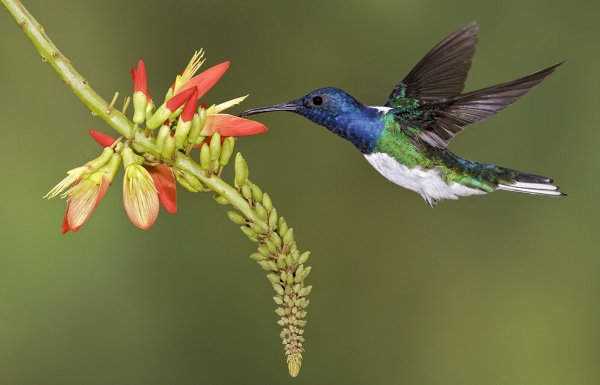
The dramatically colored White-necked Jacobin is widely distributed from southeast Mexico to Bolivia and can be found along edge habitats adjacent to urban or agricultural areas where flowers are plentiful. Glenn’s professional photo techniques utilize a number of flashes to provide ample light during overcast weather and in shaded habitats.
A Professional at Work
This weekly Bird Photography article is usually geared toward birders who enjoy photography as part of their birding experiences – advanced hobbyists if you will – although we provide information that’s useful for beginners as well as advanced photographers. In this article, we are providing insights provided by a professional bird photographer who has developed a number of specialized techniques using some of the best equipment available. This isn’t so much our usual how-to or how-it-happened article that we regularly feature; it is an insight into how some of the best images of rare hummingbirds are taken by a globe-trotting professional photographer.
With that in mind, Glenn Bartley uses professional level equipment, including a Canon EOS R5 mirrorless camera body, usually combined with a Canon 600mm f-4 IS telephoto lens. He also speaks highly of the standard among many bird photographers, the Canon 100-to-400mm f-5 IS zoom lens. Glenn also uses a professional-level tripod and tripod head, along with a synchronized flash system.

A unique image of a Purple-crowned Fairy momentarily dragging its wings in water in Costa Rica is a product of a fast shutter speed created by the Glenn’s multi-flash portable set-up.
Photo Challenges
Hummingbird photography can be fairly simple or it can be quite detailed. In the chapter of the book in which Glenn described his introduction to hummingbird photography, which provided limited success, he noted that when conditions are ideal, you can use natural sunlight when it’s bright and positioned at a low angle behind you. In fact, he explained that this is his preferred way of photographing hummingbirds. However, he pointed out that photographers frequently run into challenging or impossible lighting conditions, especially in the tropics. Hence, he developed a flash system that he can use to provide the light when natural conditions don’t afford photo options.
Glenn also explained that because hummingbirds are typically very active and dynamic subjects; and because some species prefer to stay in shaded areas of forests, or are found in mountain cloud forests and lowland rainforests where overcast weather is common, your chances of having optimum natural light to photograph are very limited. Reduced light also means your camera cannot create a fast enough shutter speed to stop the motion of flying hummingbirds, which is a preferred way to depict these flying jewels. Therefore, Glenn often relies on artificial lighting – he typically uses synchronized flashes to light the bird and the background. He often sets up a small portable “studio” in the field, usually adjacent to a nectar feeder or another point of regular attraction.
Obviously, using his flash system is an advanced bird photography technique that I will leave to Glenn to describe, but we will provide some of the best examples of his photo methods here, which are spectacular to say the least. In addition to the photo equipment and technical aspects specialized for hummingbird photography, Glenn also uses these techniques to photograph many tropical birds, as well as species that range in northern forests and other areas where there are low light conditions.
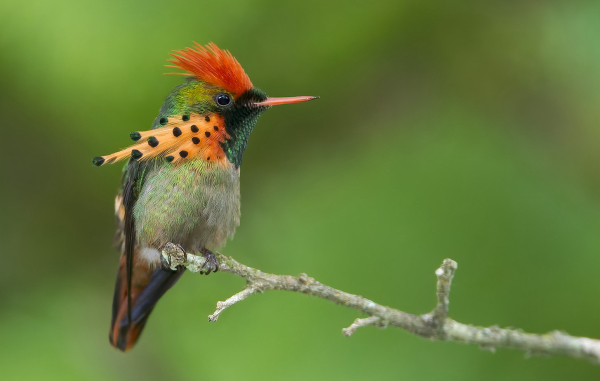
A truly remarkable example of a bird, a tiny male Tufted Coquette was photographed displaying at a perch in its territory on the Caribbean island of Trinidad, just north of the shores of northern South America.
Composition & Framing
Glenn also emphasizes the importance of being aware of the background when photographing hummingbirds, which is indeed true when photographing any bird. A great bird photo is the sum of many parts and the background can be as important as the subject when composing a given image. When possible, Glenn likes to use a part of a plant as a central focus of an image, rather than a flower cluster positioned at the edge of the photo frame. Instead, he tries to celebrate the foliage and flowers as a key part of photos, and many of his images show this emphasis beautifully.
Using artificial lighting in the way Glenn sets up, he makes it a point not to use an aperture that creates too wide an area in focus. The bright flashes permit using an f-22 aperture for example, but he has found that using a narrower area of focus helps improve the background by blurring it out of focus, which ultimately helps to emphasize sharp outlines of the bird and plants in a photograph.
He also regularly uses an oversized, out of focus photograph with pleasing natural colors, printed on a matte finish as a background, rather than relying on a lesser natural background he might find at a given site. This is a common studio method, and it ensures a simpler setup with a more predictable background element. This is another interesting ingredient to his portable field studio, and it’s important for us to be aware of the options we bird photographers can create and utilize. An important point that Glenn makes is that all the birds he photographs are free to come and go as they please; they choose to utilize the feeder and flowering plants he offers, not unlike the way we provide nectar and flowers in our yards to attract hummingbirds.
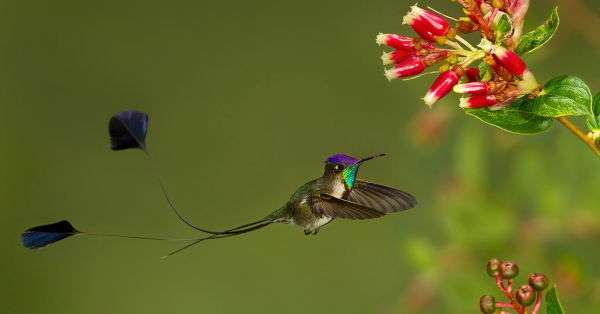
Glenn considers the rare Marvelous Spatuletail to be a “holy grail” of birds, which he was able to find and photograph in action in its limited range in northwest Peru.
Beyond Our Borders
The range of many of the hummingbirds featured in the photos shared here are far south of Mexico for the most part, with a good percentage taken in Colombia, Ecuador, and Peru, along with Costa Rica and Brazil. These nations are prime destinations for many birding tours into Latin America, and they provide exciting bird photography opportunities throughout the year. I always consider bird photography and birding-based travel to be among the highest levels of birding, and it is always an exciting opportunity to visit a new nation, even new continent, to view new birds and to photograph them. Like me, Glenn caught the international travel bug in his 20’s, and over time he has worked to improve his bird photography skills and equipment to take some of the best photographs of hummingbirds across the Americas.
A couple chapters in the book that will be most attractive to many photographers describe Glenn and Andy’s personal accounts about their photo travels and, additionally in Glenn’s case, the evolution of his photo techniques and equipment use. These chapters provide some enjoyable insights into the authors and their photo-travel interests and experiences that everyone will enjoy reading.
“Bird photography for me is about many things,” Glenn wrote. “It is about creating stunning images to share with people around the world. It’s about achieving a hard-fought goal, about being outside and using all of my senses to explore and understand the natural world in a more profound way. Perhaps more than any of these tangible outcomes, however, bird photography becomes the reason to visit wonderful and unusual places that I would otherwise never have found.”
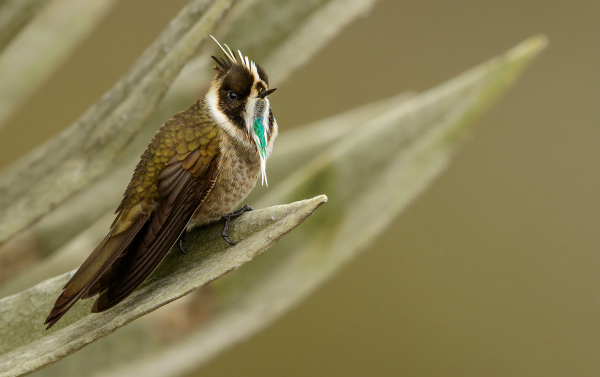
This image of a Green-bearded Helmetcrest provides a haunting hint of surrounding colors and habitat found in this species’ limited range in north-central Columbia.
Closer to home, there are hummingbirds to photograph north of the border too – probably in your home state, possibly in your yard where they are attracted to flowering plants and a nectar feeder or two. If you attract hummingbirds to your yard, you can set up your own “photo studio” and test the potential of photographing using sunlight when it shines from behind you at a low angle. Or perhaps you are an ace at using a flash when photographing and wish to try this equipment when photographing birds in your yard or another location.
In the meantime, I hope Glenn’s photos inspire you to spend a little more time photographing, and be sure to add the new book, Hummingbirds, to your library. I personally consider Hummingbirds to be the best book I’ve seen for birders in some time, and you can get more information from the publisher, Princeton University Press, at Hummingbirds | Princeton University Press
To review more of Glenn Bartley’s hummingbird images, see Hummingbirds of the World Gallery (glennbartley.com)
To review more of Glenn’s photos and other aspects of his bird photography endeavors, the best place to begin is Nature Photography Gallery - Bird Photography by Glenn Bartley
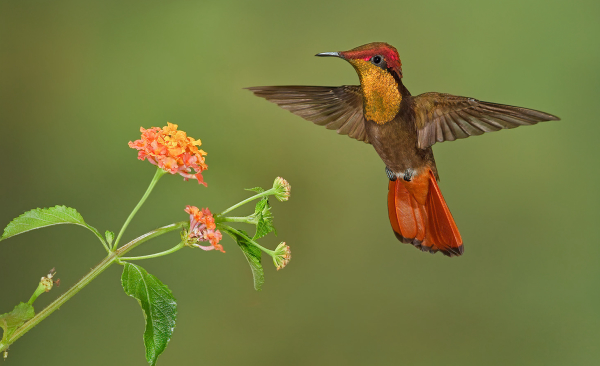
Although there are hundreds of remarkable photographs featured in Glenn and Andy’s new Hummingbirds book, we hope we have piqued your interest with the few photos we’ve shared here, including this stunning Ruby Topaz Hummingbird, a wide-ranging species found from eastern Panama to southern Brazil – so different from the hummingbirds we see north of the border.
Glenn Bartley was open and generous when I visited with him by phone last Saturday, just before he headed for Colombia where he is sharing his photographic skills and enthusiasm for birds with other birders today, this week, and beyond – Good Luck!
Photographs by Glenn Bartley
Article by Paul Konrad
Share your bird photos and birding experiences at editorstbw2@gmail.com